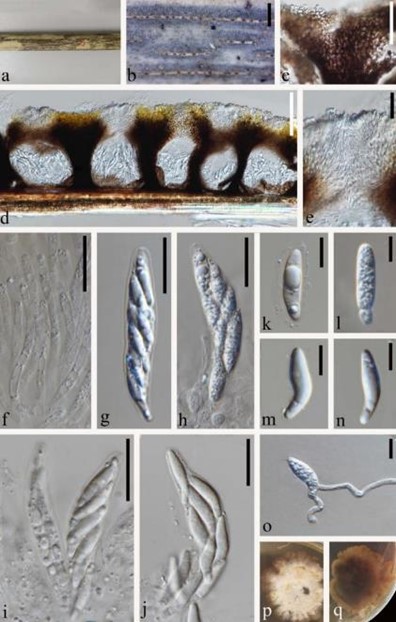Apiospora multiloculata J.Y. Zhang, Y.Z. Lu & K.D. Hyde, sp. nov.
MycoBank number: MB 559374; Index Fungorum number: IF 559374; Facesoffungi number: FoF 10637; Fig. 5
Etymology: Referring to the fungal ascostromata which is multi-loculate.
Holotype: MFLU 21-0024
Saprobic on dead bamboo culms. Sexual morph on host: Ascostromata raised, filiform, immersed to erumpent, with a periphysate ostiole, multi-loculate, gregarious, yellow to dark brown. Locules 88–160 μm diam., 155–210 μm high, immersed in stromata, arranged in a row, ampulliform to subglobose usually with flattened base, gregarious, clustered, membranous, with a central, distinct ostiole, brown to dark brown. Ostiole raised from centre of locules, internally lined with periphyses. Peridium (16–)25–48 μm thick, composed several layers of brown to dark brown cells of textura angularis. Hamathecium composed of dense paraphyses, 3–4.5 μm broad (x̅ = 3.8 μm, n = 20), unbranched, not anastomosing. Asci 65–98 × 12–20 μm (x̅ = 78.5 × 15 μm, n = 20), 8-spored, cylindrical to ellipsoidal, apically rounded, unitunicate. sessile to subsessile, Ascospores 22–28 × 4–7 μm (x̅ = 24.8 × 5.6 μm, n = 20), hyaline, partly overlapping, biseriate, 2-celled, constricted at the septum, mostly curved at the lower cell, rarely straight, with a large upper cell and a small lower cell, surrounded by an entire sheath. Asexual morph: undetermined.
Culture characteristics: Ascospores germinating on PDA within 15 hours at 25 ℃. The spore germinates from the lower cell of the ascospore, with a hyaline germ tube. Colonies grow on PDA at room temperature, slow growth, dense at the center, irregular in shape with lobate edge, flat, dense at the center, circular, with an irregular edge, flat or effuse, marginal hyphae emission, brown to pale brown in reverse from the center to margin.
Habitat: on dead bamboo culms.
Distribution: Thailand.
Material examined: Thailand, Kanchanaburi Province, Thong Pha Phum District, Pilok Subdistrict, dead bamboo culms (Poaceae), 28 June 2019, G.C. Ren Y67 (MFLU 21-0024, holotype), ex-type living culture, MFLUCC 21-0023.
GenBank numbers: ITS: XXX, LSU: XXX, tef: XXX, tub: XXX
Notes: Apiospora multiloculata formed a distinct clade, closely related to A. neosubglobosa A. subglobosa and A. tropica (ML 87%, BYPP 1.00) (Fig. 6). The closest matches of A. multiloculata are A. ovata (with 97.94% similarity in LSU and 86.76% similarity in tub gene) and A. pterosperma (with 88.27% similarity in the ITS region) based on BLAST searches from GenBank. Apiospora multiloculata formed a sexual morph on the natural substrate, which is similar to A. neosubglobosa in having clavate ascospores with a curved lower cell and yellowish-brown culture on PDA (Dai et al. 2016). However, A. multiloculata differs from A. neosubglobosa by having filiform stromata, smaller asci (65–98 × 12–20 μm vs 130–170 × 30–43 μm) and smaller ascospores (22–28 × 4–7 μm vs 39–47 × 13–16 μm). Apiospora multiloculata is introduced here as a novel species based on morphology and phylogenetic support.

Fig. 5 Apiospora multiloculata (MFLU 20–0024, holotype). a Appearance of stromata on bamboo. b Stromata. c Peridium. d Vertical section of stroma. e Ostiole with periphyses. f Paraphyses g–j Asci. k–n Ascospores. o Germinating ascospore. p-q Colony on PDA. Scale bars: b = 500 μm, c = 50 μm, d = 100 μm, e–j = 20 μm, k–o = 10 μm.

Fig. 6 Phylogram generated from ML analysis based on combined LSU, ITS, tef and tub sequence data from selected genera of Amphisphaeriales. Related sequences were retrieved from GenBank. Eighty-seven strains were included in the analysis of the combined loci and comprised 3,446 characters with 1,241 parsimony informative characters. The tree is rooted with Seiridium phylicae (CPC 19962 and CPC 19965). The best scoring RAxML tree had a final likelihood value of -33052.821490. Estimated base frequencies were: A = 0.237553, C = 0.254767, G = 0.254276, T = 0.253404; substitution rates AC = 1.183228, AG = 2.924678, AT = 1.222236, CG = 1.043323, CT = 4.741320, GT = 1.000000. GTR+I+G model was selected for LSU, ITS and tef genes, while HKY+I+G was selected for tub gene. Bootstrap values (BS) from ML higher than 50% BS and BYPP greater than 0.90 are given at the nodes. Hyphens (-) represent support values less than 50% BS/0.90 BYPP. The ex-type strains are in bold and the newly generated sequence is in blue.
